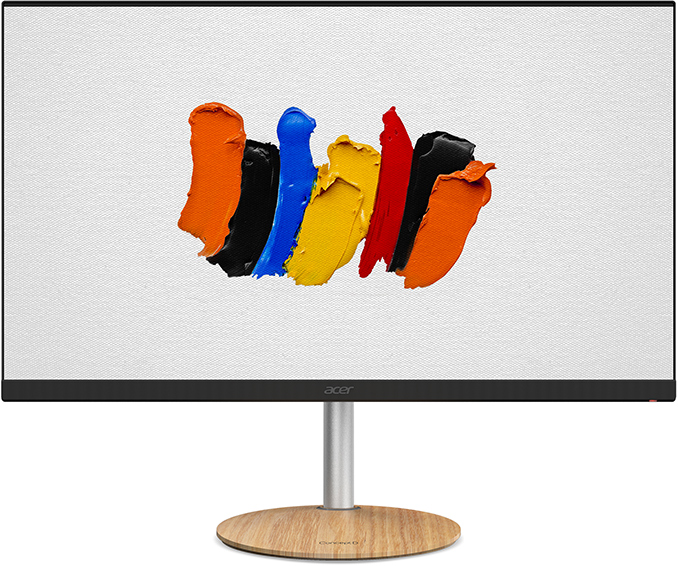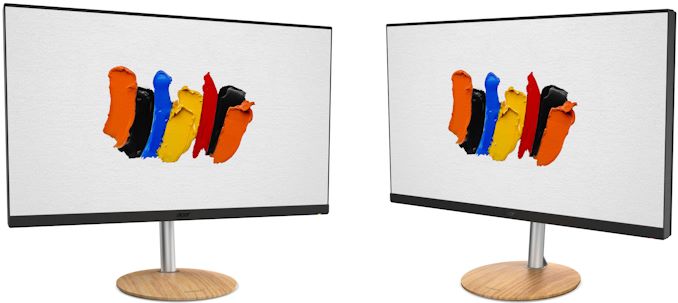Acer Joins Mini LED Monitor Club with Professional-Focused ConceptD CM7321K
by Anton Shilov on April 19, 2019 4:45 PM EST
As the era of Mini LED backlighting takes off in earnest, Acer has become another major supplier of displays to announce a monitor incorporating the tech. The ConceptD CM7321K is a high-end PC monitor that will be aimed at graphics and video professionals who need a wide color gamut, a high contrast ratio, a very high luminance, and a Delta E<1 color accuracy.
Acer's ConceptD CM7321K monitor uses a 10-bit 31.5-inch IPS panel featuring a 3840×2160 resolution, 600 - 1000-nits brightness (typical and peak in HDR mode), a 4 ms response time, a 60 Hz refresh rate, and 178°/178° horizontal/vertical viewing angles. The key feature of this display is its backlighting, with 1152 Mini LED zones for dynamic local dimming.
Backlighting based on hundreds (or thousands) of independently-controlled Mini LEDs promises to bring capabilities of LCDs closer to those of OLEDs when it comes to contrast ratio, color gamut, and brightness. Leading panel suppliers demonstrated prototypes of products outfitted with this kind of backlighting last year, with plans on the TV side of matters to start commercial shipments of Mini LED Ultra-HD televisions in 2019. As it appears, Acer and ASUS will be ready with their PC displays featuring this innovative backlighting this year as well.
In case of the ConceptD CM7321K monitor, thanks to its Mini LED-based full area local dimming (FALD) backlighting with 1152 zones, Acer is rating its contrast ratio as 100,000,000:1 when adaptive contrast management (ACM) is in use, Though it goes without saying that like other adaptive contrast setups, Acer's ACM contrast ratio should not be compared head-to-head to 'usual' contrast ratio reported by manufacturers. Meanwhile the wide spectrum of the backlight means that the display can cover 99% of the AdobeRGB and 89.5% of the Rec.2020 color gamuts.
To ensure that professionals get a good experience out of the box, Acer has validated its ConceptD CM7321K with Pantone color institute, and will ship the monitor pre-calibrated to a Delta E<1 color accuracy (presumably for all color gamuts it will support). The display also carries VESA's DisplayHDR 1000 badge, so it meets the VESA's highest standards for a HDR monitor, and this means it will support at least HDR10 (no word on Dolby Vision, though).
As far as connectivity is concerned, the monitor has two Thunderbolt 3 connectors (one input and one output to daisy chain two LCDs), four HDMI 2.0b inputs, as well as one DisplayPort 1.2. In addition, the display has two 3 Watt speakers.
| Brief Specifications of the Acer ConceptD CM7321K | ||
| Panel | 31.5" IPS | |
| Resolution | 3840 × 2160 | |
| Refresh Rate | 60 Hz | |
| Response Time | 4 ms gray-to-gray | |
| Brightness | Normal: 600 cd/m² HDR mode: 1000 cd/m² |
|
| Contrast | 100,000,000:1 (ACM) |
|
| Viewing Angles | 178°/178° horizontal/vertical | |
| Color Saturation | 99% Adobe RGB 89.5% Rec. 2020 ? DCI-P3 |
|
| Display Colors | 1.07 billion | |
| 3D-LUT | ? bits | |
| Pixel Pitch | 0.1816 mm² | |
| Pixel Density | 140 PPI | |
| Anti-Glare Coating | ? | |
| Inputs | 1 × DP 1.2 4 × HDMI 2.0b 1 × Thunderbolt 3 (one output) |
|
| USB Hub | ? | |
| Audio | 2 × 3 W speakers 3.5-mm mini jack (?) |
|
| Mechanical Design | Chassis Colors: black, metallic. wood Tilt: yes Height Adjustment: yes Swivel: yes |
|
| Power Consumption | Idle | ? |
| Active | ? | |
Finally, the high-end display will be hitting the streets in September, and with a price tag to match: Acer will be selling the monitor for $2,999/€3,199 (MSRP). Given the cutting-edge nature of Mini LED backlighting, this is not particularly surprising, as they'll make up a significant portion of the build costs on all of these first-generation Mini LED monitors.
Related Reading:
- ASUS Shows Off Dolby Vision Monitors: The ProArt PQ22UC & ProArt PA32UCX
- The New Acer ConceptD Family: Workstations and Displays for Professionals
- ASUS at CES 2019: ProArt PA32UCX 4K Monitor with 1000-Zone FALD Unveiled
- Acer Unveils ProDesigner BM270 LCD with Delta E<1 Color Accuracy: 4K, HDR, FALD
Source: Acer











30 Comments
View All Comments
Beaver M. - Sunday, April 21, 2019 - link
Even the target market benefits from 100+ Hz. Have you ever worked with a 100 Hz+ panel? Obviously not.The thing is, the panel is fast enough for 100+ Hz. All they had to do is increase the refreshrate and tweak it a bit. At that price that would be as much effort as adding RGB.
And no, theres no good options available. Most of them are AUO panels who have horrible QC and lack in one or the other field.
Only LGs new panels look promising on paper, but they havent hit the market yet.
And you also didnt get what I said: I said 60 Hz is an obsolete standard.
If one would follow your logic a 1 Hz panel would be enough.
niva - Monday, April 22, 2019 - link
You can scream "60 Hz is an obsolete standard" until you're blue in the face, but the truth is that it's not obsolete, and the vast majority of folks don't need more than 60 Hz. If you want more, buy a display that has the feature, this one is not for you.Beaver M. - Monday, April 22, 2019 - link
It is very much obsolete. Its a standard from the 90s. Manufacturers are just too cheap to go higher, even though most panels would be able to deal with it. Even though the margins are already very high, especially on monitors like this one. Do you have any idea how "much" a panel like this costs? 10% of the retail price at max.It makes even basic work much smoother and easier for the eyes. Thats a fact, and you claiming to manufacturers PR doesnt make you look very knowledgeable, but more like you work for them.
crimsonson - Monday, April 22, 2019 - link
You may have worked with 100Hz+ panel but have you actually used it or pro content creation? Any other pro you know that use it?I deal with hundreds of content pros on a daily basis (TV, film, advertisement, graphics designer, etc.). Not one of them every asked for a fast scanning monitor.
Because it is not necessary and adds nothing to their current workflow or needs.
Beaver M. - Monday, April 22, 2019 - link
Of course I did. Its much smoother, it lets you judge how your content will look much better.I am sure you never worked with one, nor do you know content creators. I do. I know a lot who ask for them.
crimsonson - Monday, April 22, 2019 - link
But "smoother" is NOT the goal of a professional reference monitor! So I'm not sure why you would say such thing. It is about accuracy. That is the single most important factor for professional video editors, VFX, colorist, compressionist, etc.This is why monitors in the low to high end of reference monitors do not have fast scan (or what ever branded name Sony, Samsung, etc use). They all have a standard refresh rate of 24, 25, 30, and 60 based. If you ever walked in to an editing room, grading room or VFX bay, if they have a TV or consumer monitor with high refresh rate feature, it is always disabled.
Please point to any professional monitor from Sony, Flanders Scientific, Panasonic, etc. Eizo has a gaming line, but their professional line do not have anything what you are describing. Maybe they do now but again, as a lead technician, I deal with content creators every day. We ilterally get zero inquiry about high refresh rate monitors. Maybe TVs? But reference monitors? Zero.
crimsonson - Monday, April 22, 2019 - link
Not to mention if you are delivering content for 50/60 display using high refresh rate will display introduce interpolation, thus inaccurate.FreckledTrout - Monday, April 22, 2019 - link
I game and don't care about anything over 60Hz. Really doesn't matter to me at all and yes I have had 120 Hz monitors, could drive them at that rate, and still don't care. If the picture quality is high and input lag on the monitor is low Im happy. I would always take a monitor with very high picture quality over a 144Hz TN.Beaver M. - Monday, April 22, 2019 - link
So you look for low input lag, but not for low response time? That makes as much sense as buying a race car with a suspension that isnt made for racing.And why do you mention TN? This is an IPS panel.
And the thing is... the picture quality isnt high with 60 Hz motion blur.
PeachNCream - Monday, April 22, 2019 - link
There is no clear need for greater than 60Hz refresh rates in most professional production environments.